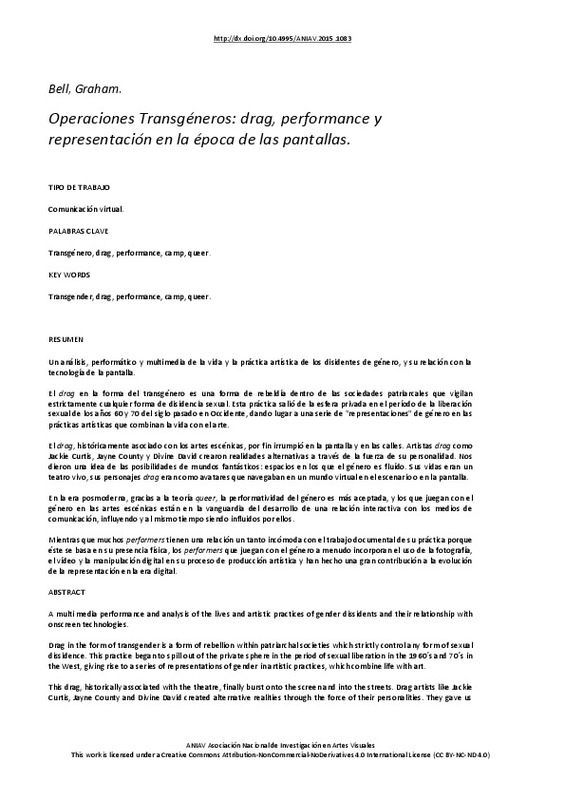JavaScript is disabled for your browser. Some features of this site may not work without it.
Buscar en RiuNet
Listar
Mi cuenta
Estadísticas
Ayuda RiuNet
Admin. UPV
Operaciones Transgeneros: drag, performance y representación en la época de la pantalla
Mostrar el registro sencillo del ítem
Ficheros en el ítem
| dc.contributor.author | Bell, Graham
|
es_ES |
| dc.date.accessioned | 2017-09-29T12:15:34Z | |
| dc.date.available | 2017-09-29T12:15:34Z | |
| dc.date.issued | 2015-10-26 | |
| dc.identifier.isbn | 9788490483411 | |
| dc.identifier.uri | http://hdl.handle.net/10251/88295 | |
| dc.description.abstract | [EN] A multi media performance and analysis of the lives and artistic practices of gender dissidents and their relationship with onscreen technologies. Drag in the form of transgender is a form of rebellion within patriarchal societies which strictly control any form of sexual dissidence. This practice began to spill out of the private sphere in the period of sexual liberation in the 1 60´s and 70´s in the West, giving rise to a series of representations of gender in artistic practices, which combine life with art. This drag, historically associated with the theatre, finally burst onto the screen and into the streets. Drag artists like Jackie Curtis, Jayne County and Divine David created alternative realities through the force of their personalities. They gave us an insight into the possibilities of fantastic worlds: spaces in which gender was fluid. Their lives were a living theatre, their drag personas like avatars navigating in a virtual world on stage or on the screen. In the postmodern era, where thanks to queer theory the performativity of gender is more widely accepted, those who play with gender in the performing arts have been at the forefront in developing an interactive relationship with the media, influencing and being influenced by it. While many performers have a somewhat uncomfortable relationship with the documentation of their practice because their work relies on their physical presence, those who play with gender often incorporate the use of photography, video and digital manipulation in the production of their work and have contributed in a major way to the evolution of representation in the digital era. | es_ES |
| dc.description.abstract | [ES] Un análisis, performático y multimedia de la vida y la práctica artística de los disidentes de género, que explora cómo la práctica de “passing” ha evolucionado con la tecnología.El “passing”, la acción de presentarse con éxito como el sexo opuesto, es un método de supervivencia dentro de sociedades que vigilan estrictamente cualquier forma de disidencia sexual. Esta práctica salió de la esfera privada en el período de la liberación sexual de los años 60 y 70 en Occidente dando lugar a una serie de "representaciones" de género en las prácticas artísticas que combinan la vida con el arte. El drag, históricamente asociado con los artes escénicas, por fin irrumpió en en la pantalla y en las calles. Artistas drag como Jackie Curtis, Mario Montez y Jayne County crearon realidades alternativas a través de la fuerza de su personalidad, mundos fantásticos que eran espacios en los que podrían sentirse seguros y satisfechos, cogiendo fuerzas para presentarse públicamente. Estos mundos eran una forma de prototipo de la realidad virtual y sus personajes drag parecidos a los avatares que navegan en el mundo virtual de la pantalla. En la era posmoderna, gracias a la teoría queer la performatividad del género es más ampliamente aceptada, y los que juegan con el género en las artes escénicas están en la vanguardia en el desarrollo de una relación interactiva con los medios de comunicación, influyendo y al mismo tiempo siendo influido por ellos.Mientras que muchos performers tienen una relación un tanto incómoda con la documentación de su práctica porque su trabajo se basa en su presencia física, los performers que juegan con el género a menudo incorporan el uso de la fotografía, el vídeo y la manipulación digital en su proceso de producción artística. Por lo tanto están estratégicamente posicionados para contribuir a la evolución de la representación en la era digital. | es_ES |
| dc.format.extent | 7 | es_ES |
| dc.language | Español | es_ES |
| dc.publisher | Editorial Universitat Politècnica de València | es_ES |
| dc.relation.ispartof | II CONGRESO INTERNACIONAL DE INVESTIGACIÓN EN ARTE VISUALES | es_ES |
| dc.rights | Reconocimiento - No comercial - Sin obra derivada (by-nc-nd) | es_ES |
| dc.subject | Arte | es_ES |
| dc.subject | Producción artística | es_ES |
| dc.subject | Estética | es_ES |
| dc.subject | Teoría del Arte | es_ES |
| dc.subject | Gestión cultural | es_ES |
| dc.subject | Educación artística | es_ES |
| dc.subject | Investigación artística | es_ES |
| dc.title | Operaciones Transgeneros: drag, performance y representación en la época de la pantalla | es_ES |
| dc.type | Capítulo de libro | es_ES |
| dc.type | Comunicación en congreso | es_ES |
| dc.identifier.doi | 10.4995/ANIAV2015.1083 | |
| dc.rights.accessRights | Abierto | es_ES |
| dc.description.bibliographicCitation | Bell, G. (2015). Operaciones Transgeneros: drag, performance y representación en la época de la pantalla. En II CONGRESO INTERNACIONAL DE INVESTIGACIÓN EN ARTE VISUALES. Editorial Universitat Politècnica de València. 762-768. https://doi.org/10.4995/ANIAV2015.1083 | es_ES |
| dc.description.accrualMethod | OCS | es_ES |
| dc.relation.conferencename | II Congreso Internacional de Investigación en Artes Visuales. |< real | virtual >| ANIAV2015 | es_ES |
| dc.relation.conferencedate | July 09-10,2015 | es_ES |
| dc.relation.conferenceplace | Valencia, Spain | es_ES |
| dc.relation.publisherversion | http://ocs.editorial.upv.es/index.php/ANIAV/ANIAV2015/paper/view/1083 | es_ES |
| dc.description.upvformatpinicio | 762 | es_ES |
| dc.description.upvformatpfin | 768 | es_ES |
| dc.type.version | info:eu-repo/semantics/publishedVersion | es_ES |
| dc.relation.pasarela | OCS\1083 | es_ES |








